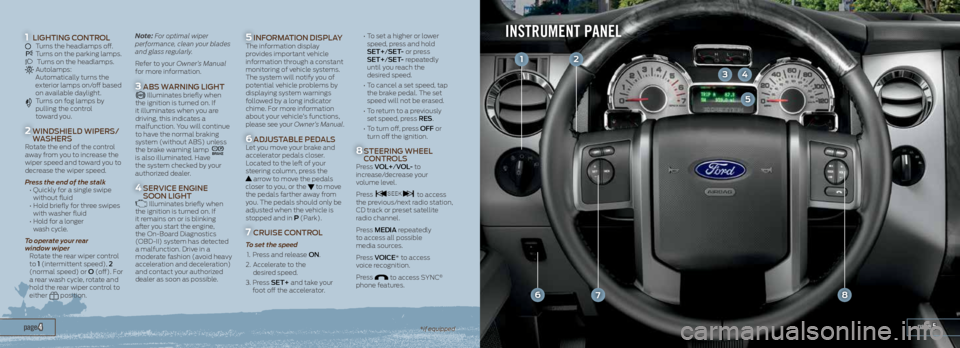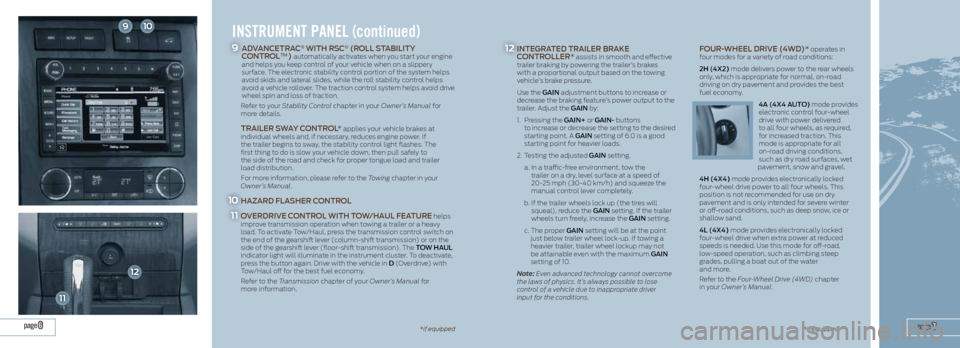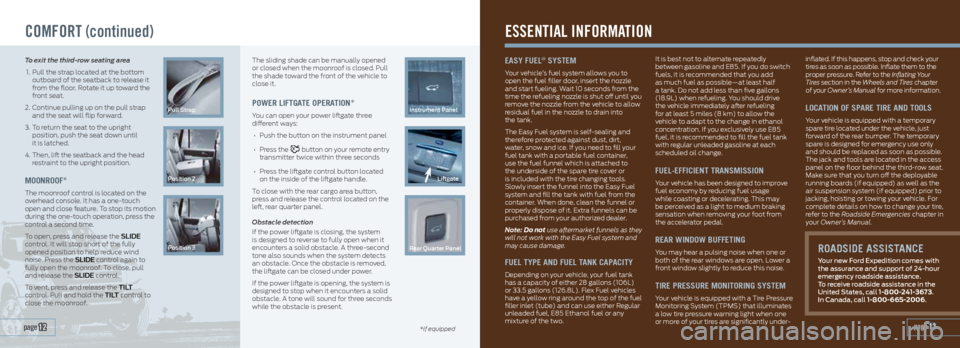tow FORD EXPEDITION 2014 3.G Quick Reference Guide
[x] Cancel search | Manufacturer: FORD, Model Year: 2014, Model line: EXPEDITION, Model: FORD EXPEDITION 2014 3.GPages: 8, PDF Size: 0.79 MB
Page 3 of 8

page 5 page 4
INSTRUMENT PANEL
*if equipped
6
12
34
5
78
1
2
3
4
5
6
7
8
LighTing C
OnTROL Turns the headlamps off. Turns on the parking lamps. Turns on the headlamps. Autolamps:
Automatically turns the
exterior lamps on/off based
on available daylight.
Turns on fog lamps by
pulling the control
toward you.
WinDShiELD WiPERS/
WAShERS
Rotate the end of the control
away from you to increase the
wiper speed and toward you to
decrease the wiper speed.
Press the end of the stalk
• Quickly for a single swipe
without fluid
• Hold briefly for three swipes
with washer fluid
• Hold for a longer
wash cycle.
To operate your rear
window wiper
Rotate the rear wiper control
to 1 (intermittent speed), 2
(normal speed) or O (off). For
a rear wash cycle, rotate and
hold the rear wiper control to
either
position. Note:
For optimal wiper
performance, clean your blades
and glass regularly.
Refer to your Owner’s Manual
for more information.
ABS W ARning LighTIlluminates briefly when
the ignition is turned on. If
it illuminates when you are
driving, this indicates a
malfunction. You will continue
to have the normal braking
system (without ABS) unless
the brake warning lamp
is also illuminated. Have
the system checked by your
authorized dealer.
SERViCE EnginE
SOOn LighT
Illuminates briefly when
the ignition is turned on. If
it remains on or is blinking
after you start the engine,
the On-Board Diagnostics
(OBD-II) system has detected
a malfunction. Drive in a
moderate fashion (avoid heavy
acceleration and deceleration)
and contact your authorized
dealer as soon as possible.
inFORMATiOn DiSPLAYThe information display
provides important vehicle
information through a constant
monitoring of vehicle systems.
The system will notify you of
potential vehicle problems by
displaying system warnings
followed by a long indicator
chime. For more information
about your vehicle’s functions,
please see your Owner’s Manual.
ADJUSTABLE PEDALS
Let you move your brake and
accelerator pedals closer.
Located to the left of your
steering column, press the
arrow to move the pedals
closer to you, or the to move
the pedals farther away from
you. The pedals should only be
adjusted when the vehicle is
stopped and in P (Park).
CRUiSE COnTROL
To set the speed
1. Press and release On.
2. Accelerate to the
desired speed.
3. Press SET+ and take your
foot off the accelerator.
•
To set a higher or lower
speed, press and hold
SET+/SET- or press
SET+/SET- repeatedly
until you reach the
desired speed.
• To cancel a set speed, tap
the brake pedal. The set
speed will not be erased.
• To return to a previously
set speed, press RES .
• To turn off, press OFF or
turn off the ignition.
STEERing WhEEL
COnTROLS
Press VOL+/VOL- to
increase/decrease your
volume level.
Press
to access
the previous/next radio station,
CD track or preset satellite
radio channel.
Press MEDiA repeatedly
to access all possible
media sources.
Press VOiCE* to access
voice recognition.
Press
to access SYNC®
phone features.
Page 4 of 8

page 7page 613*if equipped
910
11
12
INSTRUMENT PANEL (continued)
ADVAnCETRAC® WiTh RSC® (ROLL STABiLiTY
COnTROL™) automatically activates when you start your engine
and helps you keep control of your vehicle when on a slippery
surface. The electronic stability control portion of the system helps
avoid skids and lateral slides, while the roll stability control helps
avoid a vehicle rollover. The traction control system helps avoid drive
wheel spin and loss of traction.
Refer to your Stability Control chapter in your Owner’s Manual for
more details.
TRAiLER SWAY COnTROL * applies your vehicle brakes at
individual wheels and, if necessary, reduces engine power. If
the trailer begins to sway, the stability control light flashes. The
first thing to do is slow your vehicle down, then pull safely to
the side of the road and check for proper tongue load and trailer
load distribution.
For more information, please refer to the Towing chapter in your
Owner’s Manual.
hAZARD FLAShER COnTROL
OVERDRiVE COnTROL WiTh TOW/hAUL FEATURE helps
improve transmission operation when towing a trailer or a heavy
load. To activate Tow/Haul, press the transmission control switch on
the end of the gearshift lever (column-shift transmission) or on the
side of the gearshift lever (floor-shift transmission). The TOW hAUL
indicator light will illuminate in the instrument cluster. To deactivate,
press the button again. Drive with the vehicle in D (Overdrive) with
Tow/Haul off for the best fuel economy.
Refer to the Transmission chapter of your Owner’s Manual for
more information.
inTE
gRATED TRAiLER BRAKE
COnTROLLER* assists in smooth and effective
trailer braking by powering the trailer’s brakes
with a proportional output based on the towing
vehicle’s brake pressure.
Use the gAin adjustment buttons to increase or
decrease the braking feature’s power output to the
trailer. Adjust the g Ain by:
1. Pressing the gAin+ or g Ain- buttons
to increase or decrease the setting to the desired
starting point. A g Ain setting of 6.0 is a good
starting point for heavier loads.
2. Testing the adjusted g Ain setting.
a. In a traffic-free environment, tow the
trailer on a dry, level surface at a speed of
20-25 mph (30-40 km/h) and squeeze the
manual control lever completely.
b. If the trailer wheels lock up (the tires will
squeal), reduce the g Ain setting. If the trailer
wheels turn freely, increase the g Ain setting.
c. The proper gAin setting will be at the point
just below trailer wheel lock-up. If towing a
heavier trailer, trailer wheel lockup may not
be attainable even with the maximum g Ain
setting of 10.
Note: Even advanced technology cannot overcome
the laws of physics. It’s always possible to lose
control of a vehicle due to inappropriate driver
input for the conditions. FOUR-WhEEL DRiVE (4WD)* operates in
four modes for a variety of road conditions:
2h (4X2) mode delivers power to the rear wheels
only, which is appropriate for normal, on-road
driving on dry pavement and provides the best
fuel economy.
4A (4X4 AUTO) mode provides
electronic control four-wheel
drive with power delivered
to all four wheels, as required,
for increased traction. This
mode is appropriate for all
on-road driving conditions,
such as dry road surfaces, wet
pavement, snow and gravel.
4h (4X4) mode provides electronically locked
four-wheel drive power to all four wheels. This
position is not recommended for use on dry
pavement and is only intended for severe winter
or off-road conditions, such as deep snow, ice or
shallow sand.
4L (4X4) mode provides electronically locked
four-wheel drive when extra power at reduced
speeds is needed. Use this mode for off-road,
low-speed operation, such as climbing steep
grades, pulling a boat out of the water
and more.
Refer to the Four-Wheel Drive (4WD) chapter
in your Owner’s Manual.9
10
11
12
*if equipped
Page 7 of 8

COMFORT (continued)
Pull Strap
Position 2
Position 3
instrument Panel
Liftgate
Rear Quarter Panel
The sliding shade can be manually opened
or closed when the moonroof is closed. Pull
the shade toward the front of the vehicle to
close it.
Power LifTgaTe oPeraTion*
You can open your power liftgate three
different ways:
• Push the button on the instrument panel
•
Press the
button on your remote entry
transmitter twice within three seconds
•
Press the liftgate control button located
on the inside of the liftgate handle.
To close with the rear cargo area button,
press and release the control located on the
left, rear quarter panel.
Obstacle detection
If the power liftgate is closing, the system
is designed to reverse to fully open when it
encounters a solid obstacle. A three-second
tone also sounds when the system detects
an obstacle. Once the obstacle is removed,
the liftgate can be closed under power.
If the power liftgate is opening, the system is
designed to stop when it encounters a solid
obstacle. A tone will sound for three seconds
while the obstacle is present.
ESSENTIAL INFORMATION
eaSY fUeL® SYSTem
Your vehicle’s fuel system allows you to
open the fuel filler door, insert the nozzle
and start fueling. Wait 10 seconds from the
time the refueling nozzle is shut off until you
remove the nozzle from the vehicle to allow
residual fuel in the nozzle to drain into
the tank.
The Easy Fuel system is self-sealing and
therefore protected against dust, dirt,
water, snow and ice. If you need to fill your
fuel tank with a portable fuel container,
use the fuel funnel which is attached to
the underside of the spare tire cover or
is included with the tire changing tools.
Slowly insert the funnel into the Easy Fuel
system and fill the tank with fuel from the
container. When done, clean the funnel or
properly dispose of it. Extra funnels can be
purchased from your authorized dealer.
Note: Do not use aftermarket funnels as they
will not work with the Easy Fuel system and
may cause damage.
fUeL TYPe and fUeL Tank caP aciTY
Depending on your vehicle, your fuel tank
has a capacity of either 28 gallons (106L)
or 33.5 gallons (126.8L). Flex Fuel vehicles
have a yellow ring around the top of the fuel
filler inlet (tube) and can use either Regular
unleaded fuel, E85 Ethanol fuel or any
mixture of the two. It is best not to alternate repeatedly
between gasoline and E85.
If you do switch
fuels, it is recommended that you add
as much fuel as possible—at least half
a tank. Do not add less than five gallons
(18.9L) when refueling. You should drive
the vehicle immediately after refueling
for at least 5 miles (8 km) to allow the
vehicle to adapt to the change in ethanol
concentration. If you exclusively use E85
fuel, it is recommended to fill the fuel tank
with regular unleaded gasoline at each
scheduled oil change.
fUeL-efficienT TranSmiSSion
Your vehicle has been designed to improve
fuel economy by reducing fuel usage
while coasting or decelerating. This may
be perceived as a light to medium braking
sensation when removing your foot from
the accelerator pedal.
rear window BUffeTing
You may hear a pulsing noise when one or
both of the rear windows are open. Lower a
front window slightly to reduce this noise.
Tire PreSSUre moniToring SYSTem
Your vehicle is equipped with a Tire Pressure
Monitoring System (TPMS) that illuminates
a low tire pressure warning light when one
or more of your tires are significantly under- inflated.
If this happens, stop and check your
tires as soon as possible. Inflate them to the
proper pressure. Refer to the Inflating Your
Tires section in the Wheels and Tires chapter
of your Owner’s Manual for more information.
Loca Tion of SP are Tire and TooLS
Your vehicle is equipped with a temporary
spare tire located under the vehicle, just
forward of the rear bumper. The temporary
spare is designed for emergency use only
and should be replaced as soon as possible.
The jack and tools are located in the access
panel on the floor behind the third-row seat.
Make sure that you turn off the deployable
running boards (if equipped) as well as the
air suspension system (if equipped) prior to
jacking, hoisting or towing your vehicle. For
complete details on how to change your tire,
refer to the Roadside Emergencies chapter in
your Owner’s Manual.
page 13 page 12
To exit the third-row seating area
1. Pull the strap located at the bottom
outboard of the seatback to release it
from the floor. Rotate it up toward the
front seat.
2. Continue pulling up on the pull strap
and the seat will flip forward.
3. To return the seat to the upright
position, push the seat down until
it is latched.
4. Then, lift the seatback and the head
restraint to the upright position.
moonroof*
The moonroof control is located on the
overhead console. It has a one-touch
open and close feature. To stop its motion
during the one-touch operation, press the
control a second time.
To open, press and release the SLiDE
control. It will stop short of the fully
opened position to help reduce wind
noise. Press the SLiDE control again to
fully open the moonroof. To close, pull
and release the SLiDE control.
To vent, press and release the TiLT
control. Pull and hold the TiLT control to
close the moonroof.
*if equipped
roadSide aSSiST ance
Your new Ford Expedition comes with
the assurance and support of 24-hour
emergency roadside assistance.
To receive roadside assistance in the
United States, call 1-800-241-3673.
in Canada, call 1-800-665-2006.